初始层的抗切圆zp扩展Q(−m)和投降现象
IF 0.7
3区 数学
Q3 MATHEMATICS
引用次数: 0
摘要
设k=Q(−m)为虚二次域。讨论了k的反切环zp -扩展kac中k的p类群的投降性质;为此,使用基于logp函数(定理2.3,定理3.4)的新方法,我们确定了kac/k的第一层k1ac,并且我们证明了即使kac/k完全分叉,k1ac中也可能存在部分投降。我们已经推测,这种投降现象是k的zp扩展所特有的,不同于切环现象。对于p=3,我们刻画了域k(正常分裂情况)的子族,其中kac与Hilbert类域(定理5.1)不是线性不相交。没有假设3在k和k f =Q(3m)中的分裂,也没有假设它们的3类群的结构。给出了四个pari/gp程序(7.1,7.2,7.3,7.4,取决于定义2.10的分类),计算了k1ac的定义三次多项式,以及附加到字段k, k, k1ac的主要不变量;讨论了与Iwasawa不变量的一些关系(定理9.6)。本文章由计算机程序翻译,如有差异,请以英文原文为准。
Initial layer of the anti-cyclotomic Zp-extension of Q(−m) and capitulation phenomenon
Let be an imaginary quadratic field. We consider the properties of capitulation of the p-class group of k in the anti-cyclotomic -extension of k; for this, using a new approach based on the -function (Theorem 2.3, Theorem 3.4), we determine the first layer of over k, and we show that some partial capitulation may exist in , even when is totally ramified. We have conjectured that this phenomenon of capitulation is specific of the -extensions of k, distinct from the cyclotomic one. For , we characterize a sub-family of fields k (Normal Split cases) for which is not linearly disjoint from the Hilbert class field (Theorem 5.1). No assumptions are made on the splitting of 3 in k and in , nor on the structures of their 3-class groups. Four pari/gp programs (7.1, 7.2, 7.3, 7.4 depending on the classification of Definition 2.10) are given, computing a defining cubic polynomial of , and the main invariants attached to the fields k, , ; some relations with Iwasawa's invariants are discussed (Theorem 9.6).
求助全文
通过发布文献求助,成功后即可免费获取论文全文。
去求助
来源期刊

Journal of Number Theory
数学-数学
CiteScore
1.30
自引率
14.30%
发文量
122
审稿时长
16 weeks
期刊介绍:
The Journal of Number Theory (JNT) features selected research articles that represent the broad spectrum of interest in contemporary number theory and allied areas. A valuable resource for mathematicians, the journal provides an international forum for the publication of original research in this field.
The Journal of Number Theory is encouraging submissions of quality, long articles where most or all of the technical details are included. The journal now considers and welcomes also papers in Computational Number Theory.
Starting in May 2019, JNT will have a new format with 3 sections:
JNT Prime targets (possibly very long with complete proofs) high impact papers. Articles published in this section will be granted 1 year promotional open access.
JNT General Section is for shorter papers. We particularly encourage submission from junior researchers. Every attempt will be made to expedite the review process for such submissions.
Computational JNT . This section aims to provide a forum to disseminate contributions which make significant use of computer calculations to derive novel number theoretic results. There will be an online repository where supplementary codes and data can be stored.
 求助内容:
求助内容: 应助结果提醒方式:
应助结果提醒方式:


